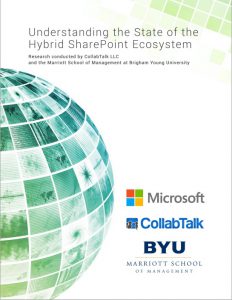Yes Virginia, Hybrid SharePoint Is Still A Thing
For many organizations who support extensive SharePoint environments, with many of their business processes and collaboration activities centered around the platform, moving to the cloud may not be as easy as flicking a switch. Between Microsoft’s efforts to provide parity between on-premises and online, as well as content and guidance on moving to the cloud, and the partner ecosystem’s many tools and deep experience in helping organizations make the move, there are more options than ever before for making the transition to the cloud. However, there are still many organizations with valid use cases for remaining on-prem. However, a hybrid SharePoint model can offer these organizations a way to ease their IT assets into the cloud.
 As many of you know, CollabTalk led a research effort into the scope of the hybrid slice of the overall SharePoint pie (Understanding of the Hybrid SharePoint Ecosystem, April 2017) which you can download for free, and which was sponsored by Microsoft, PixelMill, B&R Business Solutions, AvePoint, Crow Canyon Software, tyGraph, Rencore, Focal Point Solutions, and several community groups. Within this free report we were able to put some numbers around the hybrid path, and document feedback and real-world experiences from partners and customers before, during, and after their move to a hybrid model.
As many of you know, CollabTalk led a research effort into the scope of the hybrid slice of the overall SharePoint pie (Understanding of the Hybrid SharePoint Ecosystem, April 2017) which you can download for free, and which was sponsored by Microsoft, PixelMill, B&R Business Solutions, AvePoint, Crow Canyon Software, tyGraph, Rencore, Focal Point Solutions, and several community groups. Within this free report we were able to put some numbers around the hybrid path, and document feedback and real-world experiences from partners and customers before, during, and after their move to a hybrid model.
For companies looking seriously at how they can offload some of their workloads to Office 365 while maintaining critical business systems (with all their customizations and complexity) on-prem, the vision of a hybrid SharePoint environment — where costs can be optimized and users can be transitioned when it makes sense — is not so much a migration exercise as it is a deep dive into an organization’s business needs. Hybrid may be the logical path forward for some organizations, but moving everything to the cloud is not as simple as point and click. The best path forward is often to “baby step it,” moving one key business process or customization at a time to ensure that each can be supported, and both end user and management needs are being met.
Some guidance on planning out your transition to a hybrid model:
- Identify the use cases.
Clarify the business benefits of each workload. Common scenarios include sharing content and collaborating with customers, field personnel, or partners. But also understand the workloads that should remain (at least for the near future) within your on premises environment, such as your ticketing system, or your highly customized product development platform. Beware the hidden costs of moving to a platform that cannot support all of your business requirements — understand which use cases can be supported today, and let other use cases expand organically as your cloud platform matures.
- Clarify the relationship of data and content between platforms.
How will your on prem and cloud systems communicate, if at all? Does data or content need to be correlated (synchronized) between environments, or can these use cases and workloads be maintained separately? Key to maintaining a hybrid platform is having a clear understanding of how data, roles, and permissions are shared between platforms — and how they will be managed going forward.
- Identify the governance, compliance, reporting constraints.
An underlying problem with SharePoint deployments, in general, is that organization do not make a sufficient effort in defining success metrics, and methods for monitoring activity against those metrics, up front. It is important that you develop a governance strategy for both the old (on prem) and new (cloud) platforms, understanding (and documenting) how they will be managed individually, as well as together as a single platform. For many organization, one of the primary constraints of moving to the cloud is not necessarily the technologies (although there are some limitations, for sure) but in the inability to manage SharePoint across both environments.
- Define how end users will be transitioned.
When your use cases have been defined, your data and content requirements are being met, and your governance strategy is in place, you also need to consider the end user experience. How best to transition users to your new system? If your focus is on key use cases, your answer may be in place already. Prioritize your use cases, and work with sub-sets of users (not all at once) to transition to the new model — providing training and feedback loops, so that you can learn from the process and improve the model for future workloads.
The main message here is that moving to the cloud is never as simple as whipping out a credit card, signing up for an online service, and adding people’s emails. That may answer a very small sub-set of users for their external collaboration needs, but making a transition from an enterprise-scale on prem SharePoint deployment to a similarly equipped, feature-rich cloud solution will take time, and careful planning.
You’ll get there, but one step at a time.
And if you’re interested in the free Hybrid SharePoint report mentioned above, we are working on a follow-up pulse survey and paper, sponsored by Focal Point Solutions, Microsoft and tyGraph, to be available in late Q1 2020. Follow me on Twitter at @buckleyplanet or watch this site for updates.





1 Response
[…] Yes Virginia, Hybrid SharePoint Is Still A Thing [buckleyPLANET] […]